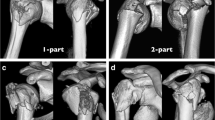Abstract
Fractures of the proximal humerus are common and their incidence increases with age and, consequently, with the degree of osteoporosis. Over time, many classification systems regarding these fractures have been proposed. The aim of classification is to define a fracture on the basis of fixed parameters (morphologic characteristics and fracture pathoanatomy) that can be used for better understanding of fracture severity, prognosis and potential surgical options. Most classifications are based on the X-ray appearance of the humeral head fracture on plain films; recently 3D-CT scans have complemented traditional radiograms. Neer developed a classification system based on fracture pathoanatomy and on the presence or absence of displacement of one or more of the four major bony segments (surgical neck, anatomic neck, greater and lesser tuberosity). The AO classification system included the concept of perfusion of the articular segment. Edelson divided humeral head fractures into five basic types that correspond to some degree to the Neer classification, but differ significantly regarding the most complex patterns of fracture. Furthermore, an interobserver reliability study indicated the improved usefulness of the 3-D concept in providing a common language among clinicians for classifying these injuries. Finally, Hertel developed a classification system for better understanding the predictors of humeral head ischemia. In conclusion, a fracture must be classified for understanding its severity and guiding the treatment. Radiographies are often not sufficient for establishing the number of fragments and the entity of their dislocation. 3D-CT scans allow medial hinge condition and other predictors of humeral head ischemia to be better understood.
Similar content being viewed by others
Bibliografia
Baron JA, Barrett JA, Karagas MR (1996) The epidemiology of peripheral fractures. Bone 18[Suppl 3]:209–213
Bengnér U, Johnell O, Redlund-Johnell I (1988) Changes in the incidence of fracture of the upper end of the humerus during a 30-year period. A study of 2125 fractures. Clin Orthop 231:179–182
Rose SH, Melton LJ 3rd, Morrey BF et al (1982) Epidemiologic features of humeral fractures. Clin Orthop 168:24–30
Horak J, Nilsson B (1975) Epidemiology of fracture of the upper end of the humerus. Clin Orthop 112:250–253
Neer CS 2nd, Rockwood CA Jr (1984) Fractures and dislocations of the shoulder. In: Rockwood CA, Green DP (Eds.) Fractures, 2nd edn. JB Lippincott, Philadelphia pp 675–707
Giannicola G, Gumina S, Cinotti G, Postacchini F (1998) Riproducibilità ed utilità clinica della classificazione di Neer nelle fratture e fratture lussazioni dell’estremo prossimale dell’omero. Giornale Italiano di Ortopedia e Traumatologia 24:323–332
Kocher T (1986) Beitrage zur Kenntnis einiger praktisch wichtiger fracturenfermen. Carl Sallman Verlag, Basel
Codman EA (1934) The shoulder. T. Todd, Boston
Dehen E (1945) Fractures of the upper end of the humerus: a classification based on the etiology of trauma. Surg Clin North Am 25:28–47
Laing PG (1956) The arterial supply to the adult humerus. J Bone Joint Surg Am 38:1105–1116
Neer CS 2nd (1970) Displaced proximal humeral fractures. I. Classification and evaluation. J Bone Joint Surg Am 52:1077–1089
Neer CS 2nd (1970) Displaced proximal humeral fractures. II. Treatment of three-part and four-part displacement. J Bone Joint Surg Am 52:1090–1103
Neer CS 2nd (2002) Four-segment classification of proximal humeral fractures: purpose and reliable use. J Shoulder Elbow Surg 11:389–400
Neer CS 2nd (1990) Shoulder reconstruction, 1st edn. Saunders, Philadelphia
Gumina S, Giannicola G, Cinotti G et al (1998) Confronto tra due classificazioni delle fratture dell’epifisi prossimale di omero: Neer e AO-ASIF.Giornale Italiano di Ortopedia e Traumatologia 24:435–442
Bernstein J, Adler LM, Blank JE et al (1996) Evaluation of the Neer system of classification of proximal humeral fractures with computerized tomographic scans and plain radiographs. J Bone Joint Surg Am 78:1371–1375
Sallay PI, Pedowitz RA, Mallon WJ et al (1997) Reliability and reproducibility of radiographic interpretation of proximal humeral fracture pathoanatomy. J Shoulder Elbow Surg 6:60–69
Jakob RP, Kristiansen T, Mayo K (1984) Classification and aspect of treatment of fractures of the proximal humerus. In: Bateman JE, Welsh RP (Eds.) Surgery of the Sshoulder. Decker, Philadelphia pp 330–343
Muller ME, Nazarian S, Koch P, Schatzker J (1990) The comprehensive classification of fractures of the long bones. Springer, Berlin, Heidelberg, New York, Tokyo
Marsh JL, Slongo TF, Agel J et al (2007) Fracture and dislocation classification compendium — 2007: Orthopaedic Trauma Association classification, database and outcomes committee. J Orthop Trauma 21[Suppl 10]:1–133
Edelson G, Kelly I, Vigder F, Reis ND (2004) A three-dimensional classification for fractures of the proximal humerus. J Bone Joint Surg Br 86:413–425
Tingart MJ, Apreleva M, von Stechow D et al (2003) The cortical thickness of the proximal humeral diaphysis predicts bone mineral density of the proximal humerus. J Bone Joint Surg Br 85:611–617
Hertel R, Hempfing A, Stiehler M, Leunig M (2004) Predictors of humeral head ischemia after intracapsular fracture of the proximal humerus. J Shoulder Elbow Surg 13:427–433
Author information
Authors and Affiliations
Rights and permissions
About this article
Cite this article
Gumina, S., Rita, A., Arceri, V. et al. Le fratture dell’estremo prossimale dell’omero: incidenza e classificazioni. LO SCAL 23, 2–7 (2009). https://doi.org/10.1007/s11639-009-0014-1
Published:
Issue Date:
DOI: https://doi.org/10.1007/s11639-009-0014-1




